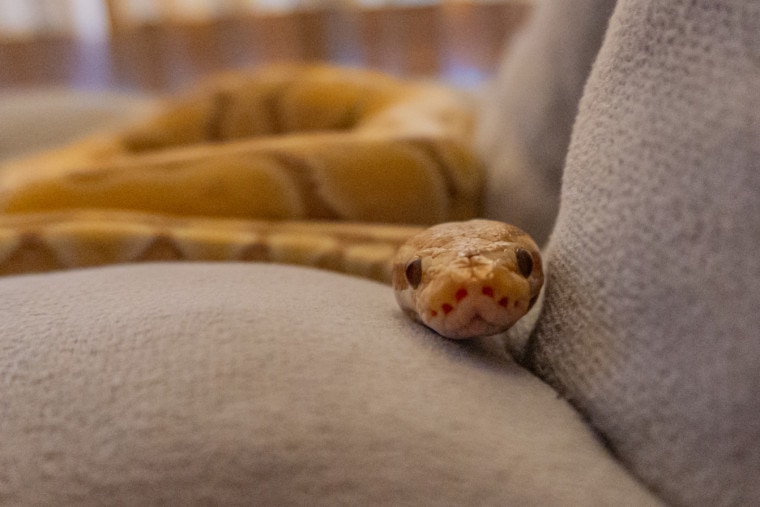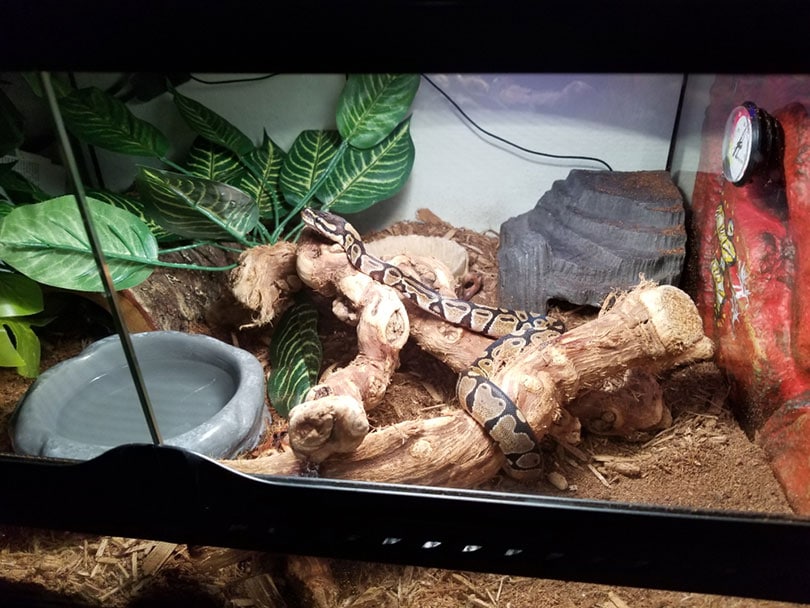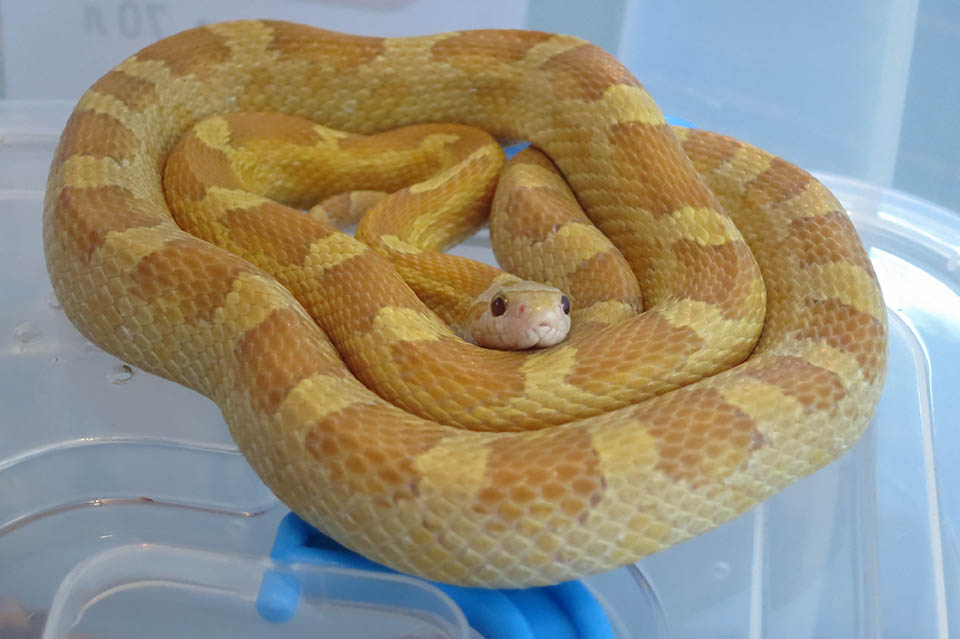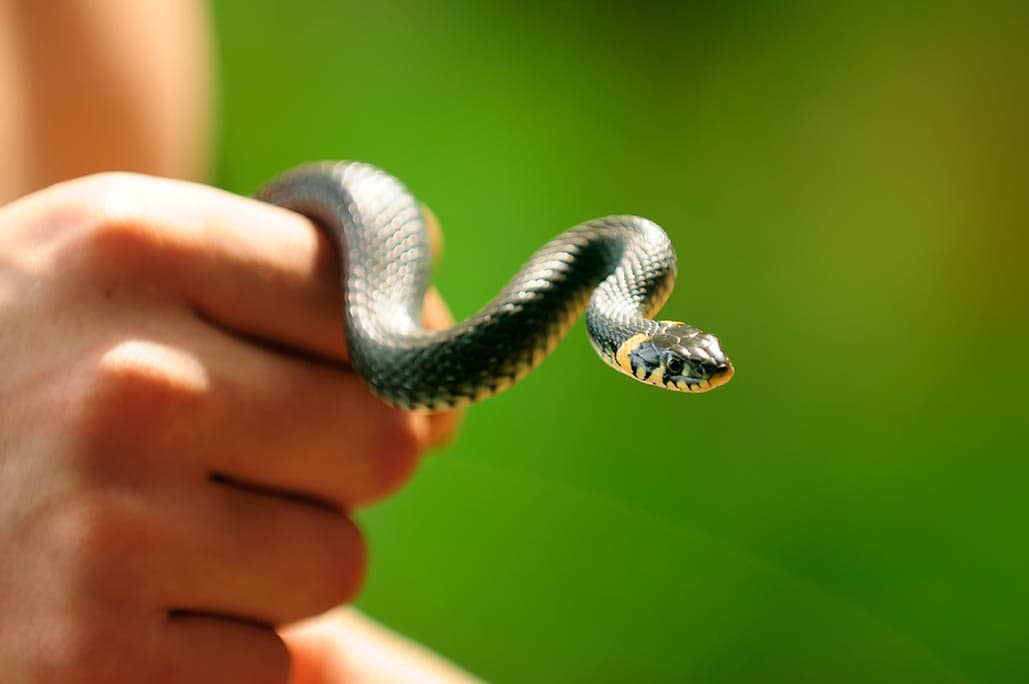
The Dreamsicle Ball python morph is a stunning snake with a bright golden yellow pattern coloration combined with pure white. First produced in 2007 by Ralph Davis Reptiles, this morph is also known as the Lavender Albino Piebald Ball python.
The Dreamsicle Ball python morphs are popular among Ball python breeders and are used to produce a variety of other morphs. These snakes are beautiful and vibrant with a calm demeanor.
Quick Facts about Dreamsicle Ball Python Morph
| Species Name: | Python Regius |
| Common Name: | Ball Python, Royal Python |
| Care Level: | Beginner |
| Lifespan: | Up to 30 years |
| Adult Size: | 2-4ft (Males) 3-6ft (Females) |
| Diet: | Mice, Rats |
| Minimum Tank Size: | 30 Gallon Vivarium (Adult) |
| Temperature & Humidity: | 85-91°F (Hot Side) 75-80°F (Cool Side) 55-60% Humidity |
Do Dreamsicle Ball Python Morphs Make Good Pets?
Dreamsicle Ball python morphs are stunning to look at and would be a great option for a novice snake owner. Young snakes can be feisty, though not always. With proper handling, they tame very easily.
Ball Pythons are relatively inexpensive to keep and have long lifespans. They are easy to handle and are well known for being docile.
Appearance
The Dreamsicle Ball python morph consists of two genes, the piebald gene, and the lavender albino gene. For this reason, the morph is also referred to as the Lavender Albino Piebald Ball python.
Lavender albino is a recessive color mutation. The mutation is similar to normal albino but develops into a lavender base color. They have deep red eye color and their yellow pattern coloration tends to be sharper and more defined than a normal albino with rich golden-yellow undertones. The piebald gene adds the famous pure white patches.
How to Take Care of a Dreamsicle Ball Python Morph
Proper husbandry is especially important as a snake owner. The Dreamsicle Ball python will have certain requirements for the habitat setup. Let’s take a look!
Habitat, Tank Conditions & Setup
Tank
Dreamsicle Ball pythons require an enclosure that is secure and well-ventilated. The vivarium can be made of glass or plastic. You need to ensure fresh water is always available to your snake. Two hides will be needed inside the tank, one for the hot side and another for the cool side.
You can start with a 10-to-20-gallon vivarium for a hatchling. The smaller size will help alleviate any stress. As juveniles, they can be housed in a 20 gallon or larger enclosure. An adult ball python should have a 30-to-40-gallon or larger enclosure. They do not spend a lot of time outside of their hides. Exceptionally large habitats aren’t necessary for Ball Pythons.
Lighting
The Dreamsicle Ball python will not require any UVB lighting but will thrive best with normal day and night cycles. As a general rule, twelve hours of light and twelve hours of darkness will work just fine.
Heating (Temperature & Humidity)
Temperature and humidity levels are vital for the health of your Dreamsicle Ball python. They are cold-blooded and cannot self-regulate their body temperature. They rely on their habitat.
You need to have a hot and cool side in the enclosure, both sides containing a hide. Heating tape or a heating mat is ideal for Ball pythons and can be installed to heat a specific area of the tank.
The hot side should be between 85-91°F and should never exceed 93°F. The cool side should be about 80°F and never below 75°F. The average ambient, or overall temperature of the enclosure should be around 82°F.
Thermometers are available for purchase to monitor the temperature. It’s recommended to have one for each side of the enclosure.
The Dreamsicle Ball python will require 55 to 60% humidity in the enclosure. The proper humidity will help ward off respiratory infections and illness. Humidity also plays a key role in the shedding process. You can purchase a hygrometer to monitor humidity levels. It’s an effective and inexpensive tool.
Substrate
Aspen bedding, coconut husk, and fir bark are some of the most popular bedding used for Ball pythons. Always avoid cedar substrate and sand.
Some great products with these substates include Repti Bark, Reptile Prime, Repti Chip, and Aspen Snake Bedding.
Tank Recommendations
| Tank Type | 40-gallon glass or plastic vivarium |
| Lighting | N/A |
| Heating | Heating pad/tape on the bottom of the enclosure |
| Best Substrate | Aspen bedding, coconut husk, fir bark |
 Feeding Your Dreamsicle Ball Python Morph
Feeding Your Dreamsicle Ball Python Morph
Dreamsicle Ball pythons can be fed live, freshly killed, or frozen-thawed mice or rats. The size of its prey should be approximate to the width of the snake at the largest part of its body.
If you opt for live feeding, always supervise your snake during the process. Live prey can cause harm. If the snake refuses the meal, it should be removed from the enclosure immediately.
Young Ball pythons need to be fed once weekly while adults eat once every two to three weeks. The frequency of adult feeding is dependent on the size of the food item, the time of year, and reproductive activity.
You may notice your Dreamsicle Ball python is a picky eater, this is not unusual. Consult with your veterinarian on the best way to ensure your snake is eating properly.
Diet Summary
| Fruits | 0% of diet |
| Insects | 0% of diet |
| Meat | 100% of diet – small/medium-sized rodents |
| Supplements Required | N/A |
Keeping Your Dreamsicle Ball Python Morph Healthy
With proper care, Dreamsicle Ball pythons are generally healthy snakes. There are some common health problems you will always want to keep on the lookout for. Do not hesitate to contact your veterinarian if you notice your snake exhibiting any odd symptoms or behavior.
Lifespan
Dreamsicle Ball pythons can have a lifespan of 20 to 30 years. In rare cases, Ball Pythons have been recorded living past 40 years of age. Owning a snake is a rewarding and long-term commitment.
Breeding
Ball Python breeding season runs from mid-September through mid-November. Females will generally lay 1 to 11 eggs per clutch.
The females reach reproductive maturity around 27 months of age. Males reach their maturity much sooner, between 16 and 18 months of age. They should not be bred prior to reproductive maturity for the sake of their health and well-being.
Are Dreamsicle Ball Python Morphs Friendly? Our Handling Advice
Dreamsicle Ball pythons should not be handled for the first several days and up to two weeks after being brought home. The travel and change of habitat can be stressful for the snake and you will need to allow them time to adjust.
Ball Pythons are generally very calm snakes and tend to be an easier species to handle. They do not require social interaction from their owner so frequent handling is not necessary. Excessive handling can cause them stress so you will want to keep that in mind. Generally, it’s recommended to handle them twice weekly to keep them tame.
Snakes can bite if they feel threatened or mistake their handlers for food. It is best to wash your hands and observe your snake’s body language before handling.
Shedding & Brumation: What to Expect
The Dreamsicle Ball python morph will shed throughout its life. Younger snakes shed more often as they continue to grow.
When your snake reaches shed time, you will notice the scales will look dull, and the eyes will start to look blue and cloudy. There is a possibility that Ball Pythons will refuse meals close to shedding time, though not always.
The proper humidity level is essential to achieve a complete shed. Some handlers will raise the humidity in the enclosure slightly when the snake starts showing signs of shedding.
Though Ball pythons do not brumate, they can skip meals during the winter months. Regular feeding usually picks back up in late winter or early spring. If your Dreamsicle Ball python refuses food for an extended period, it’s always best to contact your veterinarian.
How Much Do Dreamsicle Ball Python Morphs Cost?
Dreamsicle Ball python morphs typically cost anywhere from $2,000 to $3,000. New Ball python morphs are being produced in the pet trade frequently.
Prices tend to decrease once certain morphs become more readily available. The Dreamsicle has thus far been an exception and has maintained its price range of $2,000 to $3,000 for several years.
Care Guide Summary

Final Thoughts
The Dreamsicle Ball python is a stunning, unique animal. As with any Ball Python, you can expect a long-lived, docile companion. You will want to ensure you are prepared for the proper husbandry required as a Ball Python owner.
You can expect a heavy price tag upon purchase but whether you are a first-time snake owner, an experienced handler, or a Ball python breeder, the Dreamsicle Ball python morph would make an excellent choice.
Featured Image Credit: TKBackyard, Shutterstock






